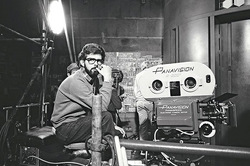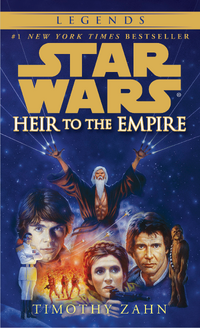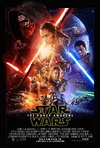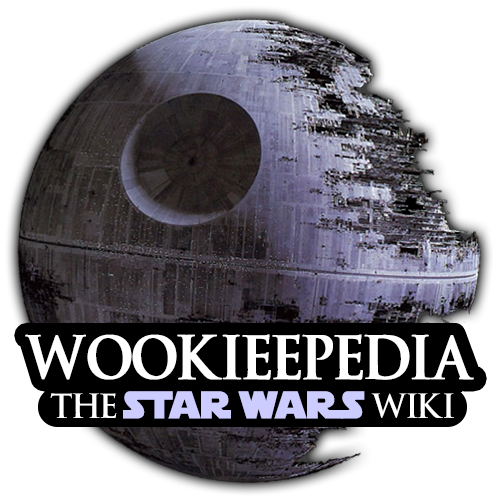- "Whether or not all nine or twelve films actually get made depends on how George feels as time goes along. The series may happen the way he originally planned or may completely change. As the films are made, each of the stories develops. As each is finished, I think the direction of the saga may change a bit."
- ―Gary Kurtz, quoted in Prevue #42 (September-October 1980)
The sequel trilogy is the third installment of films of the Star Wars saga to be produced. It begins thirty years after Star Wars: Episode VI Return of the Jedi and focuses on a conflict between the First Order, a military state and successor to the Galactic Empire, and the Resistance, a military group opposing the First Order and successor to the Alliance to Restore the Republic.
The films are produced by Lucasfilm President Kathleen Kennedy, with Bad Robot Productions having also helped produce The Force Awakens. The trilogy features the return of classic Star Wars characters Luke Skywalker, Leia Organa, Han Solo, Chewbacca, R2-D2, C-3PO, and Darth Sidious as well as a host of new characters, primarily focusing on the Force-sensitive scavenger Rey, the deserter First Order stormtrooper Finn and Kylo Ren, the son of Leia Organa and Han Solo who is the master of the Knights of Ren and who had fallen into the dark side of the Force.
Rumors of a sequel trilogy had been talked about for decades, ever since George Lucas, the creator of Star Wars, stated that he had plans for films that would take place after the original Star Wars trilogy. As the canon saga developed, however, Lucas denied that a sequel trilogy would ever be made, stating that Star Wars was the story of Anakin Skywalker and that his story ended in Return of the Jedi. The development of the sequel trilogy was made official on October 30, 2012, when The Walt Disney Company announced that it was acquiring Lucasfilm from Lucas and that they would be producing new Star Wars films beginning in 2015.
Development
Early plans
- "The prequel stories exist—where Darth Vader came from, the whole story about Darth and Ben Kenobi—and it all takes place before Luke was born. The other one—what happens to Luke afterward—is much more ethereal. I have a tiny notebook full of notes on that. If I'm really ambitious, I could proceed to figure out what would have happened to Luke."
- ―George Lucas, around the release of The Empire Strikes Back

In 1978, George Lucas said there were twelve Star Wars stories.
Ideas for a Star Wars sequel trilogy were in place as early as 1976, during the filming of the original film. Mark Hamill, who starred as Luke Skywalker in the 1977 film, recounted that George Lucas asked if he would be interested in appearing in Episode IX "around 2011," when Lucas assumed such a film would be made. According to Hamill, his character would "be like Obi-Wan Kenobi handing the lightsaber down to the next generation."[20] In 1978, after the success of A New Hope, Lucas told Time magazine that he would produce a sequel to A New Hope and then ten additional films, for a total of four Star Wars trilogies.[21] In the early 1980s, both Hamill and Lucas repeatedly told the media that the sequels would be made in the 2000s.[22][23][24][25] At first, he was considering making 12 films, three of which were "a couple of odd movies" that focused only on subjects such as droids and Wookiees. However, he abandoned his ideas for those films and focused solely on the nine-part saga.[18] At the time of the release of Star Wars: Episode V The Empire Strikes Back, Lucas confirmed that there were seven further Star Wars films he wanted to make. He said he had multiple-page outlines and titles for those films,[26][18] and that the sequel trilogy "deals with the character that survives Star Wars III and his adventures." Bantha Tracks calculated that, if production on the nine-part Star Wars epic continued at the same rate, the ninth Star Wars film could be expected in the spring of 2001.[27] A 1979 Kenner ad claimed that there were plans for "twelve more block-busting chapters to the Star Wars story."[28]
According to Gary Kurtz, the producer of A New Hope and The Empire Strikes Back, Lucas's original ideas for the sequel trilogy, which he described as "very vague" other than they involved Luke's journey into becoming a high-esteemed Jedi Knight like Obi-Wan Kenobi and his ultimate confrontation against the Emperor, were eventually condensed into Star Wars: Episode VI Return of the Jedi.[29][30][31] As Lucas told Starlog in 1981, "…what seems like a great idea when it's described in three sentences doesn't hold together when you try to make five or six scenes out of it. So plots change a lot when they start getting into script form."[32] The original plan had been for Han Solo to die and for Luke to confront Vader and then go on with life alone. The sequels would've then showed Luke becoming a full-fledged Jedi, Leia becoming Queen of the remaining people of Alderaan, and Luke finding his long-lost sister from the other side of the galaxy. Luke would've trained his sister as a Jedi and together they would've confronted the Emperor on the Imperial Capital Planet of Had Abbadon.[29][30][31] Lucas allowed biographer Dale Pollock to read the plot outlines of a 12-film saga on the condition of signing a confidentiality agreement. Pollock said these sequel trilogy drafts would "involve Luke Skywalker in his 30s and 40s," though Lucas allegedly planned to recast Hamill with an older actor due to reportedly being left dissatisfied with Hamill's performance, and that they would be "The three most exciting stories … They had propulsive action, really interesting new worlds, new characters. I remember thinking, 'I want to see these 3 movies.'"[33] Likewise, author Timothy Zahn had been briefed by Lucas on his sequel plans when he was hired by Bantam Spectra to write the Thrawn Trilogy. Lucas told him that he wanted each trilogy to follow a generation of Skywalkers, and as such, the sequels would involve Luke's children.[34]
Throughout the 1980s, Lucas revealed several ideas he had in mind for the sequels; he described it as "like a saga, the story of a group of people, a family." They would begin roughly 20 to 40 years after Return of the Jedi[18][35] and involve the core cast in their 60s or 70s,[36][37] and would deal with the rebuilding of the republic.[38] and their main theme would be "the necessity for moral choices and the wisdom needed to distinguish right from wrong."[36] "If the first trilogy is social and political and talks about how society evolves, Star Wars is more about personal growth and self realization, and the third deals with moral and philosophical problems. The sequel is about Jedi Knighthood, justice, confrontation, and passing on what you have learned." Han and Leia would be a couple.[39] R2-D2 and C-3PO would be the only characters who might continue through all nine films.[18][40][23][18] The story would focus on Luke, who would be a sixty-year-old Jedi Knight[39] in a romantic relationship with a female.[41] According to Lucas, "what happens to Luke… is much more ethereal. I have a tiny notebook full of notes on that. If I'm really ambitious, I could proceed to figure out what would have happened to Luke."[19] (Hamill also said in 1983 that if his character were to return again, it would be "on another plane of existence, or not the same character."[24][42]) Return of the Jedi director Richard Marquand mentioned to have sat down with Lucas to lay out the third trilogy's framework, which included a character described by Marquand as some kind of 'supreme intellect' who could control Darth Vader's actions, Luke Skywalker's fate and the destiny of the whole galaxy with his profound cunning.[43]
Abandonment and the Expanded Universe
- "I've left pretty explicit instructions for there not to be any more features. There will definitely be no Episodes VII-IX. That's because there isn't any story. I mean, I never thought of anything. And now there have been novels about the events after Episode VI, which isn't at all what I would have done with it. The Star Wars story is really the tragedy of Darth Vader. That is the story. Once Vader dies, he doesn't come back to life, the Emperor doesn't get cloned and Luke doesn't get married."
- ―George Lucas, May 2008, Total Film

Heir to the Empire marked the beginning of a successful publishing program that continued the saga past Return of the Jedi.
In the late 1980s and early 1990s, stories began to appear that were set during the sequel time period, telling original stories of their own. The first attempt at filling this void was the ill-fated 1986 toy line The Epic Continues by Kenner, which involved the rise of the genetics master Atha Prime and the survival of Grand Moff Tarkin.[45] More notably, Timothy Zahn's 1991 novel Heir to the Empire marked the beginning of the successful Expanded Universe of stories set after Return of the Jedi.[46] Luke started his own Jedi Academy and met and married a woman named Mara Jade, who was one of the Emperor's assistants.[47][48][49] Together they had one child, Ben Skywalker.[50] Han and Leia were married, and had three children: the twins Jacen and Jaina,[48] as well as their younger sibling Anakin.[51] Amidst their struggles to rebuild the Republic, they go up against villains such as Grand Admiral Thrawn and the extragalactic aliens known as the Yuuzhan Vong.[48][50]
At the 1987 10th Anniversary convention, Lucas reiterated the possibility of a sequel trilogy, saying that there were "nine [films] floating around there somewhere."[41] And in the foreword of the 1996 printing of Splinter of the Mind's Eye, he acknowledged that he realized early on that Star Wars was a story "that could take at least nine films to tell—three trilogies."[52] However, when asked about the sequels throughout the 1990s and 2000s, Lucas would repeat that he had no plans to make them and that he would not allow other directors to make them[53][54][44]—citing his advancing age and a lack of a firm story aside from the general concept of reuniting the original cast, dismissing his supposed interest in a nine-film saga as the media "pouncing" an off-hand comment of his,[55][37][56][57][58][59][60][61][44][62] telling Star Wars Insider in 1995: "I really don't have any other notion than 'Gee, it would be interesting to do Luke Skywalker later on.' It wouldn't be a part of the main story, it would just be a sequel to this thing."[63] However, both Steven Spielberg and Rick McCallum assured in 1999 that Lucas always intended to make nine Star Wars films because that was part of his original concept, so even if he ever made a sequel trilogy or not, the saga would still feel as a film divided in nine parts and a "one big" saga about a family that lives in a galaxy far, far away.[64] Lucas did make reference to a possible Episode VII in a May 2002 interview,[65] and in 2003, Chewbacca actor Peter Mayhew said that his contract for Star Wars: Episode III Revenge of the Sith involved a clause for a sequel trilogy.[66] In 2004, Lucas would deny the realization of a sequel trilogy once more, reaffirming that he always intended the story of Star Wars to consist in three films and he only decided to realize a prequel trilogy to go back and "do the backstory" of the original trilogy, mantaining his belief that Return of the Jedi is the saga's definitive ending.[60] Later that year, LucasArts developers led by W. Haden Blackman conceived the idea of continuing the story of the Star Wars saga through a sequel video game entitled Star Wars Episode VII: Shadows of the Sith, which would have starred an adult Ben Skywalker walking the line between the light and dark sides of the Force and unleashing never-before-seen Force powers as he investigated a new threat to the galaxy in the form of a member of the House of Solo, but the concept wasn't chosen for further development.[67]
Circa 2005, Lucas began simultaneously developing the animated series Star Wars: The Clone Wars and the live-action series Star Wars: Underworld. The mythology of these shows began to focus heavily on the criminal underworld,[68][69] with multiple arcs of the former involving the return of Darth Maul and delving deeply into esoteric aspects of the Force. Lucas was also planning to build an expansion to his Lucas Valley property called Grady Ranch, which would have been "a digital media production facility for movies and television."[70] However, in 2010, Lucas announced that the live-action series was "on hold" due to budget concerns,[71] and in early 2012, Marin County rejected Lucas's expansion plans due to concerns over traffic and noise.[72]
Disney acquisition
- "I always said I wasn't going to do any more, and that's true, because I'm not going to do any more. But that doesn't mean I'm unwilling to turn it over to Kathy to do more."
- ―George Lucas
In May 2011, while attending the opening of Star Tours: The Adventures Continue at Disney World, Disney CEO Bob Iger asked Lucas if he would be willing to sell his company. Lucas had considered retiring, but was not ready to do so at that time.[74] In January 2012, Lucas announced to The New York Times that he was planning to retire. Regarding further Star Wars films, he said: "Why would I make any more, when everybody yells at you all the time and says what a terrible person you are?"[75] In an appearance that month on The Daily Show with Jon Stewart, Lucas stated that the aerial combat footage in his 2012 American film Red Tails "is as close as you'll get to Episode VII."[76] He later credited his retirement and sale of Lucasfilm to the birth of his daughter, his advanced age (relative to the decade that he estimated it would take to make the trilogy), his plans to build a museum, and his desire for hands-on control. He told author Paul Duncan that even if he hired others to make the films, he knew he'd end up micromanaging them as he did on The Empire Strikes Back and Return of the Jedi;[77] retirement would allow him to "enjoy life for a while."[78]
While he was in New York for The Daily Show, Lucas asked Kathleen Kennedy to lunch. He asked if she would be a co-chair at Lucasfilm with him, with the intention of transferring leadership entirely to her after about a year. She began working for him on June 1, 2012; Lucas soon proposed that they work together on the sequel trilogy.[74] During this time, Lucasfilm began the early development of Episodes VII, VIII, and IX—hiring writer Michael Arndt to work on VII, with Lawrence Kasdan as a consultant.[79][80] After making an appearance at Celebration VI in late August, Lucas took Mark Hamill and Carrie Fisher to lunch and asked if they would be willing to reprise their roles for the new films.[81] According to Hamill, Lucas told them that he wasn't planning to direct them himself.[82] However, Lucas claimed that he considered directing Episode VII for a May 2015 release[83] and then selling his company.[84]
Lucas finally contacted Iger in June 2012, at which point the two companies entered five months of acquisition negotiations. Lucas worked to ensure that key Lucasfilm personnel would be able to stay on in order to market the new Star Wars films, though Iger stressed that Disney would have final say over future movies. Lucas agreed, despite his reservations about losing control, and initially did not turn over his outlines for the sequel trilogy. He finally presented the stories once some of his concerns were assuaged, and Disney agreed that the stories had potential.[79] The acquisition was announced on October 30, 2012, for which Disney paid Lucas US$4.05 billion. As part of the announcement, Disney revealed that it would be producing the sequel trilogy.[85] At this point, the first entry was scheduled for release in summer 2015.[86]
Lucas's story outlines
- "I thought I was going to have a little bit more to say about the next three because I'd already started them, but they decided they wanted to do something else. Things don't always work the way you want it. Life is like that."
- ―George Lucas
During the buying process, Lucas had completed the outlines for the trilogy and agreed to send them to Iger, CLO Alan Braverman and CCO Alan F. Horn, who affirmed that they would not be contractually obliged to use them although they would be open to using his ideas.[87] At some point, the decision was made to diverge from Lucas's outlines,[88] in favor of what Lucas later referred to as "something for the fans"[89][90] with a "retro feel." He contrasted The Force Awakens with Episodes I–VI, saying, "I worked very hard to make them completely different, with different planets, with different spaceships… to make it new."[91] Director J.J. Abrams told Vanity Fair that among the studio's concerns was that Lucas's outlines featured characters who were "very young," which seemed reminiscent of The Phantom Menace.[86] According to Iger's 2019 memoir The Ride of a Lifetime, Lucas felt "betrayed" by The Force Awakens.[87] As Lucas told Stephen Colbert: "The original Saga was about the father, the children, and the grandchildren. That's not a secret to anybody—it's even in the novels and everything. The children were in their 20s and everything, so it wasn't The Phantom Menace again. But they've taken it in a different direction, and I'm excited—they didn't use my story, so I don't know what they're doing."[92][93] Hamill agreed, later saying they were "vastly different to what they have done,"[94] and remarking "When I have George on the phone, we are talking about the 7th and the 8th movie. But I will not betray his trust and I will keep what he tells me confidential."[95] In an October 2020 livestream, Lucas told a group of high-school students, "I kind of lost control of Star Wars, so it's going off in a different path than what I intended. But the first six are very much mine and my philosophy."[96] Kennedy defended these decisions, however, telling Slashfilm that "We changed the order of a few things, let's put it that way. We didn't make some wholesale change."[97] and explaining to Vanity Fair that the development team had "made some departures exactly the way you would in any development process."[86]
Lucas has said that, whereas the prequel trilogy was about the father (Anakin) and the original trilogy was about the son (Luke), the sequels would've centered around the daughter (Leia) and the grandchildren (who were in their 20s).[93] Much of the plot was inspired by the aftermath of the Iraq War; Leia works to rebuild the Republic from the remnants of the Empire, which have fallen into the hands of the criminal underworld. Darth Maul has united these criminal factions and consolidated power. A number of stormtroopers have also set up control of their own planets and continued to fight even though the Galactic Civil War had ended. Lucas compared them to the formation of ISIS after Saddam Hussein's death following the Iraq War.[77] Luke tries to rebuild the Jedi, seeking out survivors of Order 66 as well as new young recruits, while Maul also trained an apprentice: a Twi'lek named Darth Talon (originally a character from the Dark Horse Comics' Star Wars: Legacy comic book[98]), who seduces Han and Leia's son to the dark side of the Force.[99] Lucas described her as "the new Darth Vader," and said that between Maul and Talon, most of the action involved the latter.[100] (Lucas was also planning to involve Maul and Talon in the canceled video game Battle of the Sith Lords.[101]) At the beginning of the story a 14-year-old Force-sensitive girl[102][103] (whose possible names were Taryn, Thea, Winkie[102] and later Kira under Abrams[104][105][106][103]) finds her way to Luke, who is living in self-imposed exile in an ancient Jedi temple. At first, Luke is in a dark state of mind, but slowly returns to his old self, and ultimately agrees to train the girl.[107][103] According to Pablo Hidalgo's Star Wars: Fascinating Facts, Luke would have died in Episode VIII,[108] while Mark Hamill stated that Luke would have survived until Episode IX and trained Leia in the Force.[109][110] In the midst of this, we would've learned the mythology surrounding the Whills.[111][112] By the end of the trilogy, Luke Skywalker rebuilds much of the Jedi Order, and Leia becames the Supreme Chancellor of the New Republic, thus, as Lucas said, "she ended to be the Chosen One."[77]
Production
- "Our vision for Star Wars: The Force Awakens is a different vision than George's, and it is going somewhere that we can't predict, but it also reflects our life and times—while striving to be just as visionary."
- ―Production Designer Rick Carter

The cast of Star Wars Episode VII
In late 2012, Lucasfilm assembled a think tank that included Michael Arndt (who wrote the initial script), Kiri Hart, Lawrence Kasdan, Pablo Hidalgo and Simon Kinberg.[113][114][115][116] The group worked sporadically over several months, meeting at locations such as Big Rock Ranch, Skywalker Ranch and the Presidio. Kathleen Kennedy would occasionally attend, as well as various members of the Lucasfilm Story Group. As Hart told The Hollywood Reporter, "It was very collaborative, with all these conversations taking place around a big whiteboard. It was very much about putting ideas up on the board and exploring together. There were millions of things that we bounced around and abandoned."[113] Lucas was also set to advise,[14][85] but he stepped away due to the departure from his original outlines.[117][89][79] However, the creative team did use Lucas's outlines as a starting point, and retained certain elements from them[97] as they developed a very general idea of where the trilogy's story would go.[118][97][119][120] Among Arndt's contributions was the idea that, after Leia had worked to rebuild the Republic, she was pushed out of politics due to the public revelation that her father had been Darth Vader. This was later used as a plot point for the 2016 novel Bloodline.[121]
After J.J. Abrams joined the group in January 2013, they began began meeting at his Bad Robot office and also at Kennedy's nearby office.[113] Abrams was then announced as director,[1] and he and Kasdan were largely given creative control, after which which they heavily modified much of Arndt's script.[6] Kasdan later recounted the situation to The New York Times: "They were getting close to when they were supposed to start production. We had nothing. So they came to me and said, 'Will you do this with J.J.? We told Michael and he's good with it.' I said all right. It was just us. They got rid of everybody."[114] Kennedy offered Abrams the opportunity to direct all three films, but he declined, feeling overwhelmed.[122] She thus decided to replicate how the original trilogy was produced, in that each film would have a different director who could apply their personal vision.[120]
Despite laying the groundwork for the sequel trilogy, Abrams and Kasdan did not devise a firm plan for the next two movies. As Kasdan told zap2it.com: "We should have, but we didn't. What we thought was it was a big enough job to wind up with something we really like." … "Nothing is settled at the end of this movie, so that suggests Episode VIII and IX. But we did not say we had to lay that out. That's someone else's job."[123] He reiterated this sentiment to Vanity Fair and the Los Angeles Times,[124][125] telling the former, "We definitely wanted it to be open-ended and we didn't want to dictate where it was going. These movies—and people underestimate this—all six of the movies that preceded this... are determined by the director who did them."[124] For his part, Abrams said: "We don't write a treatment but there are countless times we came up with something and said 'oh, this would be so great for Episode VIII!' or 'That's what we could get to in IX!' […] We also knew that certain things were inevitable in our minds but that didn't mean it would be inevitable for whoever came in next."[126] Speaking to collider.com in 2021, Abrams expressed regret at this lack of a firm plan.[127]
Rian Johnson was hired in 2014 to write and direct Episode VIII.[3] Johnson wrote the film largely in response to The Force Awakens and with help from the Lucasfilm Story Group,[128][129] though Abrams gave him suggestions on where he thought the story should go. As Abrams told cinemablend.com: "Larry Kasdan and I, who wrote the script together, definitely were setting things up and were conscious of the fact… which is a really weird opportunity in features to know that this was going to be the beginning of a three-picture story. So we were working on versions of what we knew we would have done or wanted to do and had meetings with Rian and Ram [Bergman], who is a producer, very early on and went over what we were thinking. But also knew that Rian had his own ideas coming in. He was going to take this thing in the place that he felt right."[130] Another think tank occurred that year, at which some plot elements of Episode IX were established.[121] In 2015, Colin Trevorrow was announced to direct Episode IX.[131] His script, dated December 2016 and co-written with Derek Connolly, was entitled Duel of the Fates.[132][133] Following the prominence of Harrison Ford's character in The Force Awakens and Mark Hamill's character in The Last Jedi, the Duel of the Fates script reportedly showcased Carrie Fisher's character.[134][135] However, after Fisher's death in December 2016, Kennedy said that the team had "pretty much started over."[136] In September 2017, it was announced that Trevorrow had left the project due to creative differences,[137] and that he had been replaced by The Force Awakens director/co-writer J.J. Abrams.[2] Abrams' film, The Rise of Skywalker, differed significantly from Duel of the Fates, but used elements from that script.[138]
Films
| Image | Film | U.S. release date | Director(s) | Screenwriter(s) | Producer(s) |
|---|---|---|---|---|---|

|
Star Wars: Episode VII The Force Awakens | December 18, 2015 | J.J. Abrams | Lawrence Kasdan & J.J. Abrams and Michael Arndt | Kathleen Kennedy, J.J. Abrams, Bryan Burk |

|
Star Wars: Episode VIII The Last Jedi | December 15, 2017 | Rian Johnson | Kathleen Kennedy, Ram Bergman | |

|
Star Wars: Episode IX The Rise of Skywalker | December 20, 2019 | J.J. Abrams | J.J. Abrams and Chris Terrio | Kathleen Kennedy, J.J. Abrams, Michelle Rejwan |
Legacy
- "The future of interconnected storytelling will allow fans to explore this galaxy in deeper ways than ever before."
- ―Kathleen Kennedy
Following the Disney buyout of Lucasfilm and the official announcement of the sequel trilogy, a number of major changes were made to the company. In 2013, production was halted on Star Wars: The Clone Wars and Star Wars Detours.[140] Also in 2013, LucasArts was shut down, its projects canceled (including Star Wars: 1313, Star Wars: First Assault and Star Wars: The Force Unleashed III),[141][142] and an exclusivity deal signed with Electronic Arts.[143][144] In 2014, Lucasfilm announced that the filmmakers of the sequel trilogy would not be required to follow the post–Return of the Jedi story that was developed in the Star Wars Expanded Universe—a decision made in order to maximize their creative freedom. The Expanded Universe was re-branded and re-printed under the Star Wars Legends banner, while a new publishing program began under the guidance of the newly formed Lucasfilm Story Group. Some elements of the Legends stories are retained and used in these new stories.[139]
A series of "anthology" films began development concurrent with the sequel trilogy, with the first two (Rogue One and Solo) rolled out in an alternating pattern with the sequel releases.[145] The initial plan was to release at least one film per year indefinitely, with films to be released "well beyond" the sequel trilogy.[146][147] However, in the wake of Solo's poor box-office performance, Bob Iger announced a "slow down" of releases,[148] saying, "We will take a pause, some time, and reset … There will be other Stars Wars movies, but there will be a bit of a hiatus."[149] A number of these films have been announced over the years, including a Josh Trank film,[150] Rian Johnson trilogy,[151] a film series from David Benioff and D.B. Weiss,[152] a Kevin Feige film,[153] a Taika Waititi film,[154] and a Patty Jenkins film.[155] However, not all of these have panned out, with both Josh Trank and David Benioff & D.B. Weiss departing their respective projects.[156][157]
Shortly before the release of The Rise of Skywalker, Star Wars: Galaxy's Edge—a Star Wars–themed land heavily focused on the sequel trilogy—opened at Disney parks.[158] Also that year, the first live-action Star Wars series—The Mandalorian—debuted on Disney's new online streaming service, Disney+. Following its success, multiple new streaming shows were announced in late 2020.[155][159]

